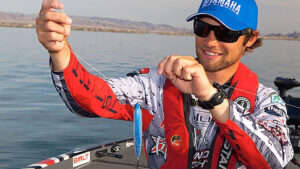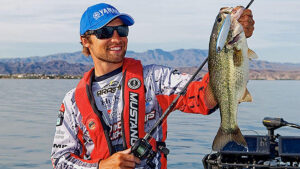This past May while practicing for the Bassmaster Elite Series tournament on Lake Havasu, Brandon Palaniuk tied on a big topwater lure to use in the ultra-clear water. The Yamaha pro finished 10th in the event, and now, three months later, he still has that same lure on his rod.
“It’ll be there until late October or early November as long as the water remains warm and clear,” Palaniuk said. “Because to me, summertime means topwater time whenever I’m fishing in clear water. Once the water temperature reaches about 70 degrees, baitfish normally start moving closer to the surface and bass begin relying more on their vision for feeding.
“A lure that moves a lot of water and makes a big commotion immediately gets their attention. You can literally ‘call’ bass to a topwater lure and because you’re working the lure pretty fast, you can cover a lot of water at the same time. They’ve been a primary choice for summer fishing for years in clear water.”
The Yamaha pro’s preferred lure choice has a distinct and extremely effective side to side action known as “walking.” These types of lures are not new—in fact, they’ve been used by bass anglers for more than 80 years. The original walking lure was the Zaragossa Minnow, but its name was soon changed to the Zara Spook, which is still made to this day.
“These lures really are easy to fish,” said Palaniuk, who has designed his own walking bait for one of his sponsors. “I try to make a long cast then incorporate short, quick downward snaps with my rod tip to get the bait moving. You need to do this with a little slack in your line, which is why the lure swishes from side to side. When you get into a steady cadence, the lure literally walks across the surface.
“When I’m fishing specifically for largemouths, I’ll stop my retrieve periodically to let the lure sit for a moment. For smallmouth, however, the most productive retrieve is often faster and without any pauses. My basic rule of thumb, which seems to be pretty universal, is the clearer the water and the cleaner the bottom, the faster I can retrieve, making bass strike out of reflex.”
Palaniuk rigs these topwater lures on a 7-foot, medium-action rod and 20-pound braided line. Because he’s fishing clear water, he adds a 4 or 5-foot leader of 20-pound monofilament line. He avoids fluorocarbon line because it sinks and hinders his lure action.
“I’ve caught bass walking topwaters in over 30 feet of water,” Palaniuk said. “But most of the time I’m working it a little more shallow. I particularly look for ambush points where bass may be hiding, which can include long rocky points, grass lines, visible cover like brush and rock piles and even submerged timber. I want the fish to have close access to deep water and again, I always search for the clearest water I can find.”
In contrast to other topwater patterns, which typically last only an hour or two in the early morning and perhaps another hour late in the afternoon, big walking lures may attract strikes throughout the entire day. Some of Palaniuk’s best times frequently occur around midday, when he’s caught fish in the 5 to 7-pound class. Because these types of lures cause so much commotion, Palaniuk doesn’t limit himself to calm conditions, either—he likes a slight ripple on the surface, and has even caught bass in 3-foot rollers.
“I’m convinced the absolute keys to catching bass with these types of lures in the summer are fishing in clear water and causing a lot of disturbance,” emphasized the Yamaha pro. “Bass are relying heavily on their vision when they’re feeding and surface lures get their attention immediately. After that, their instinct just takes over.”















